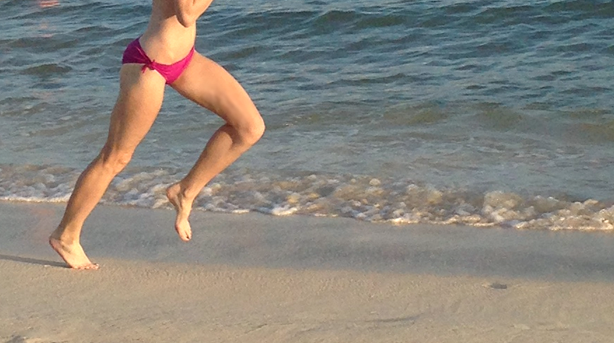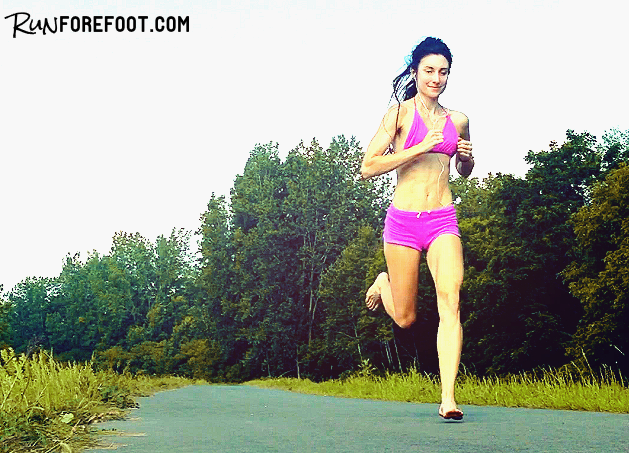Running barefoot does guarantee injury free running and the mechanism involved is proprioception.
High exposure to proprioceptive input increases activity in brain areas involved in regulating natural running gait —forefoot running— as well as avoidance behaviors. These areas of the brain include the posterior parietal cortex, the prefrontal cortex and the supplementary motor cortex.
Below discusses the effects of barefoot and shod conditions on the capacity of these brain areas to regulate biomechanics during running.
Does Running Barefoot Guarantee Injury Free Running?
Posterior Parietal Cortex : Barefoot vs Shod
The posterior parietal cortex relies on somatosensory stimuli via proprioceptive input from the bare foot.
- This area of the brain prepares us for an upcoming response and helps us keep track of our forefoot strike position relative to the ground (Sheldon & Newsome, 1996).
When running shoes are worn, runners have difficulty accurately perceiving the part of their foot that is contacting the ground. In many cases, many shod runners who think they are landing on their forefoot, are actually landing closer to the heel.
Prefrontal Cortex – Barefoot vs Shod
The prefrontal cortex responds to sensory signals that lead to a movement. For example, landing on the heel when barefoot hurts, so the prefrontal cortex tells us to land forefooted for comfort. The prefrontal cortex also helps us plan movements (Hoshi et al. 2000).
- The prefrontal cortex knows that running barefoot on pavement requires a lighter forefoot strike as compared with running on grass, therefore the prefrontal cortex plans foot strike intensity according to the terrain you are running on.
In cushioned running shoes, the proprioceptive loss results in a poorly planned foot strike, often causing us to land harder on hard surfaces.
Supplementary Motor Cortex- Barefoot vs Shod
This area of the brain directs the planning and organization of a rapid sequence of movements in a particular order.
- Concentration of intentions actually increases activity in the supplementary motor cortex ( Lau et al. 2004).
- When learning the barefoot running technique, the supplementary motor cortex is better able to help you bend your knee, land forefooted, bring the heel down, and then pull the leg up off the ground to set up for the next step.
The proper landing patterns derive from the feeling of intention prior to the movements — the supplementary motor cortex works to ensure that you use the correct sequence of movements to keep your landings soft when you run barefoot.
In shoes however, the true feeling of the ground is lost, and you have less of an urge to pull or retract the foot from the ground. This is why many shod runners have a smaller back kick compared to barefoot runners.
The Take Home Message
The dissimilarities in biomechanics between barefoot and shod runners imply that the brain behaves differently depending on what you wear on your feet; a running shoe temporarily cuts off the brain’s plantar proprioception supply, making running a risky business for most.

Lastly, it is a well-known fact that the brain is highly plastic and will change in response to a variety interventions. From this perspective, the best biomechanical enhancer for injury free running is running barefoot. Like barefoot runners, runners who prefer barefoot inspired running shoes excel at gaining more control over their forefoot strike, also.
More on How to Achieve Injury Free Running:
- Tips on How Forefoot Running Prevents Injury
- Avoid Heel Strike
- How to Improve Ankle Strength
- Why You Should Reconsider Stretching Before You Run
References:
Hoshi et al. Integration of target and body-part information in the premotor cortex when planning action. Nature, 2000;408:466-470.
Lau et al. Attention to intention. Sci, 2004;303:1208-1210
Shalden MN and Newsome WT. Motion perception: seeing and deciding. Proceedings of the National Academy of Science, USA, 1996;93:628-633.
Bretta Riches
BSc Neurobiology; MSc Biomechanics candidate, ultra minimalist runner & founder of RunForefoot. I was a heel striker, always injured. I was inspired by the great Tirunesh Dibaba to try forefoot running. Now, I'm injury free. This is why I launched Run Forefoot, to advocate the health & performance benefits of forefoot running and to raise awareness on the dangers of heel striking, because the world needs to know.
Latest posts by Bretta Riches (see all)
- Does Foot Strike Really Matter in Running? YES! - 17/04/2024
- Heel Lifts Increase Injury in Runners - 16/04/2024
- Are Minimalist Shoes Good for Seniors? YES! - 14/04/2024


Leave a Reply